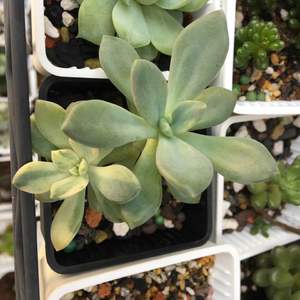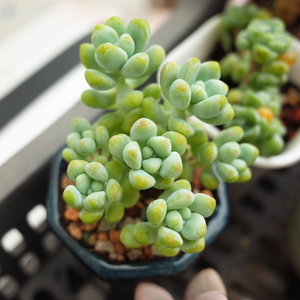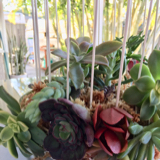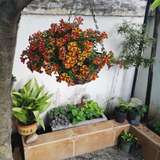成长记
涟漪潋滟
2018年07月12日

7月9日播下番茄黄瓜和中药种子,今天金太阳番茄已经发芽,播3出3,黑樱桃出1,黄瓜出1。7月12日播下各种香草种子,由于没有用东西遮盖,可能被老鼠造访了,有些种子是不需覆土的,可能已经被搞乱或不见。12日全植物施了一种叫超敏蛋白的水溶肥。本来是用酵素肥的,但酵素可能缺少微量元素,所以找了这个肥互补。


0
0
文章
Miss Chen
2018年07月10日

Description: This herbaceous biennial plant is a low-growing rosette of basal leaves during the first year, but during the second year it becomes 3-6' tall. The second-year plant is little branched below, but produces short flowering side stems above. The stems are rather stout, round or slightly ridged in circumference, and light green to slightly reddish green. Young stems are covered with white cobwebby hairs, but older stems become glabrous and have conspicuous longitudinal veins. The basal leaves are up to 2' long and 1½' across. They have long petioles and resemble the leaves of rhubarb to some extent. The lower leaves of second year plants resemble the basal leaves, except that they are somewhat smaller. These leaves are ovate-cordate, dull green above, and whitish green below, with blunt tips. They are nearly glabrous above, but finely pubescent below. Their margins are somewhat undulate, crisped, or smooth, sometimes with a few blunt teeth. Their long petioles have a conspicuous furrow above and they are usually hollow inside. The middle to upper leaves of second year plants are similar in appearance, but they are smaller in size and more likely to be ovate with margins that are more smooth and petioles that are shorter.
The upper stems terminate in small clusters of flowerheads on short stalks. Each flowerhead is about ¾–1" across, consisting of numerous disk florets and floral bracts that have narrow hooked tips. There are no ray florets. Each disk floret has a corolla that is narrowly cylindrical with 5 slender upright lobes at the apex. The disk florets are usually some shade of pink or purple, although a rare form of Common Burdock with white florets occurs. The slender white style is strongly exerted from the corolla and bifurcated at its tip. The dark purple anthers form a sheath around the style that lies just above the lobes of the corolla. The abundant bracts are green at the base, but become yellowish green toward the their hooked tips. They have a spiny appearance and have few, if any, cobwebby hairs in their midst. The blooming period occurs from mid-summer to early fall, and lasts about a month for a colony of plants. The achenes are oblong, broader and more truncate at one end than the other, and light brown with dark brown speckles. At the apex, each achene has a crown of fine bristles, but these are deciduous and soon fall off. The floral bracts turn brown and enclose the withered flowers at the top, forming a bur. The burs are persistent and remain on the stalks after the leaves have withered away during the fall. The root system consists of a stout taproot that runs deep into the ground. This plant spreads by reseeding itself, and often forms colonies of variable size.
Cultivation: Common Burdock is often found in full or partial sun, slightly moist to mesic conditions, and a loamy fertile soil. It has a robust nature and can be found in other kinds of soil and drier conditions. It is often aggressive.

Range & Habitat: This non-native plant is common in central and northern Illinois, but less common or absent in southern Illinois (see Distribution Map). This is by far the most common Arctium sp. (Burdock) in the state. It is adventive from Northern Europe and also occurs in Asia. Habitats include woodland edges, savannas, thickets, pastures, edges of fields and fence rows, weedy meadows, barnyards, areas along roads and railroads, and waste areas. Disturbed areas are preferred, although it occasionally appears in more pristine natural areas, particularly along paths and animal trails.
Faunal Associations: The flowers are pollinated primarily by long-tongued bees, including bumblebees, honeybees, Miner bees, and Leaf-Cutting bees, which suck nectar and collect pollen. Other visitors include bee flies, butterflies, and skippers, which seek nectar and are also effective at pollination. The caterpillars of several Papaipema spp. (Borer Moths) bore through the pith of the stems, including Papaipema cataphracta (Burdock Borer Moth), Papaipema arctivorens (Northern Burdock Borer Moth), and Papaipema rigida (Rigid Sunflower Borer Moth). The foliage of Common Burdock is one of the food sources for the caterpillars of the butterfly Vanessa cardui (Painted Lady). The Ring-Necked Pheasant eats the seeds to a limited extent. Because the foliage is bitter-tasting, Common Burdock is not a preferred food plant for mammalian herbivores, although livestock and deer will browse on it if nothing else is available. There is some evidence that the foliage may be toxic to rabbits. The seeds are distributed far and wide by animals and humans because the burs cling readily to fur and clothing. They are quite difficult to remove.

Photographic Location: Along a fence row at the webmaster's apartment complex in Urbana, Illinois.
Comments: Apparently, the stout taproot has a sweet taste and can be used as food. Similarly, if the outer husk of the stems are peeled away, the pith can be used like a vegetable. There are 3 Arctium spp. (Burdocks) in Illinois. One of them, Arctium tomentosum (Woolly Burdock) has abundant cobwebby hairs that cover the floral bracts below their hooked tips. Another species, Arctium lappa (Great Burdock), is often taller than Common Burdock, and it has larger flowerheads about 1–1½" across. The flowerheads of Great Burdock have longer stalks and they are arranged in flat-headed cymes, whereas the flowerheads of Common Burdock are more vertically bunched together on short stalks, as revealed in the upper photograph. The petioles of the lower leaves in Great Burdock are less furrowed on the upper surface and they are solid inside, rather than hollow.
The upper stems terminate in small clusters of flowerheads on short stalks. Each flowerhead is about ¾–1" across, consisting of numerous disk florets and floral bracts that have narrow hooked tips. There are no ray florets. Each disk floret has a corolla that is narrowly cylindrical with 5 slender upright lobes at the apex. The disk florets are usually some shade of pink or purple, although a rare form of Common Burdock with white florets occurs. The slender white style is strongly exerted from the corolla and bifurcated at its tip. The dark purple anthers form a sheath around the style that lies just above the lobes of the corolla. The abundant bracts are green at the base, but become yellowish green toward the their hooked tips. They have a spiny appearance and have few, if any, cobwebby hairs in their midst. The blooming period occurs from mid-summer to early fall, and lasts about a month for a colony of plants. The achenes are oblong, broader and more truncate at one end than the other, and light brown with dark brown speckles. At the apex, each achene has a crown of fine bristles, but these are deciduous and soon fall off. The floral bracts turn brown and enclose the withered flowers at the top, forming a bur. The burs are persistent and remain on the stalks after the leaves have withered away during the fall. The root system consists of a stout taproot that runs deep into the ground. This plant spreads by reseeding itself, and often forms colonies of variable size.
Cultivation: Common Burdock is often found in full or partial sun, slightly moist to mesic conditions, and a loamy fertile soil. It has a robust nature and can be found in other kinds of soil and drier conditions. It is often aggressive.

Range & Habitat: This non-native plant is common in central and northern Illinois, but less common or absent in southern Illinois (see Distribution Map). This is by far the most common Arctium sp. (Burdock) in the state. It is adventive from Northern Europe and also occurs in Asia. Habitats include woodland edges, savannas, thickets, pastures, edges of fields and fence rows, weedy meadows, barnyards, areas along roads and railroads, and waste areas. Disturbed areas are preferred, although it occasionally appears in more pristine natural areas, particularly along paths and animal trails.
Faunal Associations: The flowers are pollinated primarily by long-tongued bees, including bumblebees, honeybees, Miner bees, and Leaf-Cutting bees, which suck nectar and collect pollen. Other visitors include bee flies, butterflies, and skippers, which seek nectar and are also effective at pollination. The caterpillars of several Papaipema spp. (Borer Moths) bore through the pith of the stems, including Papaipema cataphracta (Burdock Borer Moth), Papaipema arctivorens (Northern Burdock Borer Moth), and Papaipema rigida (Rigid Sunflower Borer Moth). The foliage of Common Burdock is one of the food sources for the caterpillars of the butterfly Vanessa cardui (Painted Lady). The Ring-Necked Pheasant eats the seeds to a limited extent. Because the foliage is bitter-tasting, Common Burdock is not a preferred food plant for mammalian herbivores, although livestock and deer will browse on it if nothing else is available. There is some evidence that the foliage may be toxic to rabbits. The seeds are distributed far and wide by animals and humans because the burs cling readily to fur and clothing. They are quite difficult to remove.

Photographic Location: Along a fence row at the webmaster's apartment complex in Urbana, Illinois.
Comments: Apparently, the stout taproot has a sweet taste and can be used as food. Similarly, if the outer husk of the stems are peeled away, the pith can be used like a vegetable. There are 3 Arctium spp. (Burdocks) in Illinois. One of them, Arctium tomentosum (Woolly Burdock) has abundant cobwebby hairs that cover the floral bracts below their hooked tips. Another species, Arctium lappa (Great Burdock), is often taller than Common Burdock, and it has larger flowerheads about 1–1½" across. The flowerheads of Great Burdock have longer stalks and they are arranged in flat-headed cymes, whereas the flowerheads of Common Burdock are more vertically bunched together on short stalks, as revealed in the upper photograph. The petioles of the lower leaves in Great Burdock are less furrowed on the upper surface and they are solid inside, rather than hollow.
0
0
文章
Miss Chen
2018年07月09日

Description: This plant is a summer annual about 1-3' tall that is either sparingly branched or unbranched. The central stem is stout, round, light green, and more or less covered with white hairs; it also has fine longitudinal veins that are white. The alternate leaves are up to 6" long and 4" across (excluding the petioles), becoming smaller in the upper half of the central stem. They are cordate-ovate or elliptic and smooth or slightly undulate along the margins. The base of each leaf is rounded or wedge-shaped, while its tip is rounded and blunt. The lower surface of each leaf is usually pubescent, while the upper surface is less pubescent or hairless.
The central stem terminates in a stout panicle of spikes with whitish green flowers. This terminal inflorescence is up to 6" long (rarely longer in large plants). There are also shorter axilllary panicles of flowering spikes or simple spikes that develop from the axils of the middle to upper leaves. The flowering spikes are bristly in appearance from the crowded flowers and pointed bracts. Rough Pigweed is usually monoecious with separate pistillate (female) and staminate (male) flowers on the same plant. The pistillate flowers have 5 pale white sepals, an ovary with 3 styles, and no petals. The staminate flowers have 5 pale white sepals, 5 stamens, and no petals. The sepals are oblong and about 3 mm. in length; their tips are either short and pointed or flattened. At the base of each flower, there are one or more green bracts about 3-6 mm. long. These bracts have long pointed tips. The blooming period occurs from late summer to early fall and lasts about 1-2 months. Cross-pollination of the flowers is by wind. Each pistillate flower develops a single seed in a membranous bladder (utricle). This utricle splits up to release the seed. Each small seed is dark brown or black, flattened, and circular; it has a smooth and shiny surface. The root system consists of a short stout taproot that is usually tinted red. This plant spreads by reseeding itself.

Cultivation: This plant is typically found in full sun, mesic to dry conditions, and a soil containing loam, clay-loam, or gravelly material. Its size can vary significantly according to moisture levels and the fertility of the soil. The seeds can remain viable in the soil for 30 years or more.
Range & Habitat: The non-native Rough Pigweed is a common plant that occurs in most counties of Illinois (see Distribution Map). It is originally from South America. Habitats include degraded upland prairies, cropland, fallow fields, farm lots, gardens, gravelly areas along roads and railroads, sunny areas along the foundations of buildings, and waste areas. Highly disturbed areas are preferred.

Faunal Associations: Insects rarely visit the wind-pollinated flowers. The caterpillars of the skipper Pholisora catullus (Common Sootywing) feed on the foliage, as do the caterpillars of several moths, including Holomelina aurantiaca (Orange Holomelina), Hymenia perspectalis (Spotted Beet Webworm Moth), Spilosoma congrua (Agreeable Tiger Moth), and Spoladea recurvalis (Hawaiian Beet Webworm Moth). Sometimes Disonycha spp. (Flea Beetles) chew little holes in the leaves. The seeds of pigweeds are very popular with granivorus birds as a source of food during the fall and winter (see Bird Table). Pigs and cattle eat pigweeds readily, although the foliage can cause bloating and other symptoms of nitrate poisoning if an excessive amount of the foliage is eatened. Deer and rabbits eat pigweeds to a limited extent.
Photographic Location: Along the pebbly foundation of the webmaster's apartment building in Urbana, Illinois.

Comments: Rough Pigweed is another weedy member of the Amaranth family, although its seeds are an important source of food to birds. It is quite similar in appearance to another common weed, Amaranthus hybridus (Slender Amaranth), and prefers similar habitats (perhaps those that are slightly drier). Rough Pigweed tends to be shorter and stouter in its growth habit than Slender Pigweed. The flowering spikes of Rough Pigweed are usually more stout and bristly than those of Slender Pigweed; the flowering spikes of Rough Pigweed are whitish green while in bloom, while the flowering spikes of Slender Pigweed are more green (because its sepals are less conspicuous). Using a 10x hand lense, it is possible to observe that the sepals of Rough Pigweed often have flattened tips, while the sepals of Slender Pigweed are more pointed at their tips. Furthermore, the floral bracts of Rough Pigweed are up to 6 mm. in length, while those of Slender Pigweed are up to 4 mm. in length. Red forms of Rough Pigweed apparently don't occur; reddish pigweeds are usually Slender Pigweed, or less often a cultivated Amaranth that has escaped from gardens.
The central stem terminates in a stout panicle of spikes with whitish green flowers. This terminal inflorescence is up to 6" long (rarely longer in large plants). There are also shorter axilllary panicles of flowering spikes or simple spikes that develop from the axils of the middle to upper leaves. The flowering spikes are bristly in appearance from the crowded flowers and pointed bracts. Rough Pigweed is usually monoecious with separate pistillate (female) and staminate (male) flowers on the same plant. The pistillate flowers have 5 pale white sepals, an ovary with 3 styles, and no petals. The staminate flowers have 5 pale white sepals, 5 stamens, and no petals. The sepals are oblong and about 3 mm. in length; their tips are either short and pointed or flattened. At the base of each flower, there are one or more green bracts about 3-6 mm. long. These bracts have long pointed tips. The blooming period occurs from late summer to early fall and lasts about 1-2 months. Cross-pollination of the flowers is by wind. Each pistillate flower develops a single seed in a membranous bladder (utricle). This utricle splits up to release the seed. Each small seed is dark brown or black, flattened, and circular; it has a smooth and shiny surface. The root system consists of a short stout taproot that is usually tinted red. This plant spreads by reseeding itself.

Cultivation: This plant is typically found in full sun, mesic to dry conditions, and a soil containing loam, clay-loam, or gravelly material. Its size can vary significantly according to moisture levels and the fertility of the soil. The seeds can remain viable in the soil for 30 years or more.
Range & Habitat: The non-native Rough Pigweed is a common plant that occurs in most counties of Illinois (see Distribution Map). It is originally from South America. Habitats include degraded upland prairies, cropland, fallow fields, farm lots, gardens, gravelly areas along roads and railroads, sunny areas along the foundations of buildings, and waste areas. Highly disturbed areas are preferred.

Faunal Associations: Insects rarely visit the wind-pollinated flowers. The caterpillars of the skipper Pholisora catullus (Common Sootywing) feed on the foliage, as do the caterpillars of several moths, including Holomelina aurantiaca (Orange Holomelina), Hymenia perspectalis (Spotted Beet Webworm Moth), Spilosoma congrua (Agreeable Tiger Moth), and Spoladea recurvalis (Hawaiian Beet Webworm Moth). Sometimes Disonycha spp. (Flea Beetles) chew little holes in the leaves. The seeds of pigweeds are very popular with granivorus birds as a source of food during the fall and winter (see Bird Table). Pigs and cattle eat pigweeds readily, although the foliage can cause bloating and other symptoms of nitrate poisoning if an excessive amount of the foliage is eatened. Deer and rabbits eat pigweeds to a limited extent.
Photographic Location: Along the pebbly foundation of the webmaster's apartment building in Urbana, Illinois.

Comments: Rough Pigweed is another weedy member of the Amaranth family, although its seeds are an important source of food to birds. It is quite similar in appearance to another common weed, Amaranthus hybridus (Slender Amaranth), and prefers similar habitats (perhaps those that are slightly drier). Rough Pigweed tends to be shorter and stouter in its growth habit than Slender Pigweed. The flowering spikes of Rough Pigweed are usually more stout and bristly than those of Slender Pigweed; the flowering spikes of Rough Pigweed are whitish green while in bloom, while the flowering spikes of Slender Pigweed are more green (because its sepals are less conspicuous). Using a 10x hand lense, it is possible to observe that the sepals of Rough Pigweed often have flattened tips, while the sepals of Slender Pigweed are more pointed at their tips. Furthermore, the floral bracts of Rough Pigweed are up to 6 mm. in length, while those of Slender Pigweed are up to 4 mm. in length. Red forms of Rough Pigweed apparently don't occur; reddish pigweeds are usually Slender Pigweed, or less often a cultivated Amaranth that has escaped from gardens.
0
0
文章
Miss Chen
2018年07月09日

Description: This plant is a biennial. During the 1st year it consists of a small rosette of leaves, while during the 2nd year it becomes a little-branched plant about 1-3' tall. The leaves of 1st year plants are up to 2" long and across. They are cordate-orbicular with margins that are dentate or wavy and their upper surface has a reticulated network of veins. The petioles of these basal leaves are rather long and slender. The alternate leaves of 2nd year plants have a similar appearance, except that they are usually longer than wide, spanning up to 3" long and 2" across. The lower and middle leaves along the stems are usually cordate with either acute or blunt tips, while the upper leaves are often ovate. Both the stems and petioles of 2nd year plants are occasionally hairy, otherwise they are glabrous like the blades of the leaves. The foliage is often light green or yellowish green in appearance, otherwise it is medium green. The upper stems terminate in narrow racemes of white flowers. While in bloom, these flowers are bunched together toward the top of the raceme. However, as the flowers mature and develop seedpods, the raceme becomes more elongated and they become more separated.
Each flower is about ¼" across, consisting of 4 white petals, 4 light green sepals, a short cylindrical style, and several stamens with pale yellow anthers. The pedicels of flowers while they are in bloom are up to ¼" in length, although they become longer later. The blooming period occurs during late spring or early summer, lasting about 1-2 months. The flowers are replaced by narrow seedpods that are called "siliques." These seedpods are about 1½–2" long and narrowly cylindrical (although slightly 4-angled in circumference). Relative to erect stalk of the raceme, they are more or less ascending. As the seedpods become mature, the foliage dies down by the end of summer. Each mature seedpod contains a single row of black oblongoid seeds. The root system consists of a shallow taproot that is white and branches frequently. This plant often forms colonies by reseeding itself.
Cultivation: The preference is partial sun to medium shade, moist to mesic conditions, and a loamy fertile soil. Small rosettes of leaves are formed during the summer of the 1st year, which die down to the ground during the winter. However, during the spring of the following year, new leaves appear on stems that develop rapidly to produce flowers by early summer. This plant is well-adapted to deciduous woodlands and can reseed itself aggressively, forming dense stands that exclude other species. It has few problems with pests and disease organisms.

Range & Habitat: The non-native Garlic Mustard has been reported primarily in NE and central Illinois, where it is locally common. In other areas of the state, this plant is apparently less common or absent, however it is rapidly spreading (see Distribution Map). There is little doubt that it is more common than official records indicate. This plant was introduced into the United States from Eurasia. Habitats include moist to slightly dry deciduous woodlands, woodland borders, areas along woodland paths, semi-shaded areas in gardens and along fence rows, and partially shaded waste areas. This plant thrives in light shade or partial sun and it is intolerant of regular mowing. At the present time, Garlic Mustard is the worst herbaceous invader of deciduous woodlands in Illinois as it has the capacity to crowd out and destroy all of the native wildflowers that bloom during the spring. Effective measures of control include pulling the plants by their roots and spraying the foliage with herbicides. Cutting the flowering stalks from their stems is not an adequate method of control because Garlic Mustard is capable of regenerating new flowering stalks from lateral stems. Also, mature seeds can develop from any cut stalks of flowers and immature seedpods that are left on the ground.

Faunal Associations: The flowers attract various kinds small bees and flower flies. In sunnier areas, they may also attract an introduced butterfly, Pieris rapae (Cabbage White). There appears to be very few native insects that feed on the foliage and other parts of Garlic Mustard. Two flea beetles, Phyllotreta cruciferae and Phyllotreta punctulata, have been reported by Clark et al. (2004) to feed on this plant. These flea beetles also feed on other species in the Mustard family. At the present time, ecologists are examining insect pests of Garlic Mustard in Europe to determine if any of them are suitable for introduction in North America. So far, two species of leaf beetles appear to be the best candidates for biological control. Apparently the seeds are little-used by birds and mammalian herbivores rarely bother the foliage, possibly because they're repelled by its garlic-like scent. Considering how rapidly this plant has spread, it is thought that its seeds cling to the muddy feet of White-tailed Deer and the shoes of humans. This would explain its common occurrence along woodland paths.

Photographic Location: The edge of a deciduous woodland at Judge Webber Park in Urbana, Illinois.
Comments: Garlic Mustard was introduced into the United States as a potherb. The young leaves are edible to humans and quite nutritious – they can be added to salads or boiled in water and seasoned like spinach. The garlic-like aroma of the foliage is quite pronounced, which sets this species apart from many other members of the Mustard family (as well as plants from other families). Some Cardamine spp. (Bitter Cress species) are somewhat similar in appearance to Garlic Mustard, but their foliage lacks a garlic scent and their leaves are usually lobed. Some members of the Mint family have leaves that resemble those of Garlic Mustard, but they differ by having opposite leaves and 4-angled stems; they also lack the elongated seedpods that are typical of both Garlic Mustard and species of Bitter Cress.
Each flower is about ¼" across, consisting of 4 white petals, 4 light green sepals, a short cylindrical style, and several stamens with pale yellow anthers. The pedicels of flowers while they are in bloom are up to ¼" in length, although they become longer later. The blooming period occurs during late spring or early summer, lasting about 1-2 months. The flowers are replaced by narrow seedpods that are called "siliques." These seedpods are about 1½–2" long and narrowly cylindrical (although slightly 4-angled in circumference). Relative to erect stalk of the raceme, they are more or less ascending. As the seedpods become mature, the foliage dies down by the end of summer. Each mature seedpod contains a single row of black oblongoid seeds. The root system consists of a shallow taproot that is white and branches frequently. This plant often forms colonies by reseeding itself.
Cultivation: The preference is partial sun to medium shade, moist to mesic conditions, and a loamy fertile soil. Small rosettes of leaves are formed during the summer of the 1st year, which die down to the ground during the winter. However, during the spring of the following year, new leaves appear on stems that develop rapidly to produce flowers by early summer. This plant is well-adapted to deciduous woodlands and can reseed itself aggressively, forming dense stands that exclude other species. It has few problems with pests and disease organisms.

Range & Habitat: The non-native Garlic Mustard has been reported primarily in NE and central Illinois, where it is locally common. In other areas of the state, this plant is apparently less common or absent, however it is rapidly spreading (see Distribution Map). There is little doubt that it is more common than official records indicate. This plant was introduced into the United States from Eurasia. Habitats include moist to slightly dry deciduous woodlands, woodland borders, areas along woodland paths, semi-shaded areas in gardens and along fence rows, and partially shaded waste areas. This plant thrives in light shade or partial sun and it is intolerant of regular mowing. At the present time, Garlic Mustard is the worst herbaceous invader of deciduous woodlands in Illinois as it has the capacity to crowd out and destroy all of the native wildflowers that bloom during the spring. Effective measures of control include pulling the plants by their roots and spraying the foliage with herbicides. Cutting the flowering stalks from their stems is not an adequate method of control because Garlic Mustard is capable of regenerating new flowering stalks from lateral stems. Also, mature seeds can develop from any cut stalks of flowers and immature seedpods that are left on the ground.

Faunal Associations: The flowers attract various kinds small bees and flower flies. In sunnier areas, they may also attract an introduced butterfly, Pieris rapae (Cabbage White). There appears to be very few native insects that feed on the foliage and other parts of Garlic Mustard. Two flea beetles, Phyllotreta cruciferae and Phyllotreta punctulata, have been reported by Clark et al. (2004) to feed on this plant. These flea beetles also feed on other species in the Mustard family. At the present time, ecologists are examining insect pests of Garlic Mustard in Europe to determine if any of them are suitable for introduction in North America. So far, two species of leaf beetles appear to be the best candidates for biological control. Apparently the seeds are little-used by birds and mammalian herbivores rarely bother the foliage, possibly because they're repelled by its garlic-like scent. Considering how rapidly this plant has spread, it is thought that its seeds cling to the muddy feet of White-tailed Deer and the shoes of humans. This would explain its common occurrence along woodland paths.

Photographic Location: The edge of a deciduous woodland at Judge Webber Park in Urbana, Illinois.
Comments: Garlic Mustard was introduced into the United States as a potherb. The young leaves are edible to humans and quite nutritious – they can be added to salads or boiled in water and seasoned like spinach. The garlic-like aroma of the foliage is quite pronounced, which sets this species apart from many other members of the Mustard family (as well as plants from other families). Some Cardamine spp. (Bitter Cress species) are somewhat similar in appearance to Garlic Mustard, but their foliage lacks a garlic scent and their leaves are usually lobed. Some members of the Mint family have leaves that resemble those of Garlic Mustard, but they differ by having opposite leaves and 4-angled stems; they also lack the elongated seedpods that are typical of both Garlic Mustard and species of Bitter Cress.
0
0
文章
Miss Chen
2018年07月08日

Description: This herbaceous perennial plant is 4-12" tall and unbranched, consisting of a rosette of leaves and a flowering stalk. The basal leaves are up to 3" long and 1" across. They are evergreen or semi-evergreen, obovate (spoon-shaped), and nearly hairless. Their margins are crenate and slightly undulate. The flowering stalk is 4-angled and slightly pubescent or hairy. The opposite leaves along this stalk are similar to the basal leaves, except that they are smaller in size and ovate. The flowers occur in a whorled spike along the upper half of the leafy stalk. They are produced in abundance and densely distributed along this spike. Each tubular flower is about 1/2–2/3" (12-17 mm.) in length, consisting of a 2-lipped corolla and a green calyx with 5 teeth. The corolla is usually various shades of blue-violet, and less often pink or white. There are dark blue-violet lines that lead toward the throat of the corolla; they function as nectar guides. The upper lip of the corolla is truncated and very small, while the large lower lip has 3 rounded lobes. The middle lobe of the lower lip is notched at its tip and the largest in size. The outer surface of the corolla behind the lobes is conspicuously hairy; this causes the flower buds to appear hairy.
The blooming period occurs during the spring and lasts about 2-3 weeks. Each flower is replaced by 4 nutlets that are oval-shaped and pitted across the surface. The root system consists of a crown of fibrous roots. Green stolons up to 12" long are produced from the rosette of basal leaves. They are largely naked, except for a few small leaves that are narrowly ovate. These stolons often form new plantlets by rooting at their tips. Carpet Bugle can reproduce by seeds or vegetatively by means of these stolons; it often forms colonies.
Cultivation: The preference is partial sun, slightly moist to mesic conditions, and a fertile loamy soil that is somewhat acidic. If the soil is poorly drained and soggy, crown rot can develop and spread rapidly. In sandy soil, the roots are occasionally attacked by nematodes.

Range & Habitat: The non-native Carpet Bugle can escape from cultivation in gardens, but it is still uncommon in the wild, occurring in NE Illinois and Jackson County in southern Illinois (see Distribution Map). Habitats include partially shaded areas of lawns, edges of yards, partially shaded areas along foundations of buildings, nursery plots, and edges of woodlands. This plant is occasionally used as a ground cover because of its evergreen leaves and low spreading habit, but it is potentially invasive of natural areas. In Eurasia, where it is native, this plant occurs in partially shaded areas of deciduous woodlands, thickets, or meadows; the flowers bloom before the leaves of the trees have become fully developed.
Faunal Associations: The flowers are pollinated by bumblebees and other long-tongued bees. According to sources within the horticulture industry, the foliage is rarely bothered by rabbits and deer.

Photographic Location: The photographs were taken underneath a tree at Dave Monk's postage stamp prairie in Champaign, Illinois, and along the side of a house in NW Ohio.
Comments: Different cultivars of Carpet Bugle are available through the horticultural industry that can vary considerably in the color of their flowers and foliage. The only other Ajuga sp. that has naturalized in Illinois is Ajuga genevensis (Geneva Bugle). This species is slightly taller with stems and leaves that are more hairy than Carpet Bugle; it also doesn't produce stolons. Carpet Bugle is easy to distinguish from other members of the Mint family because of the following combination of features: 1) Its blue-violet flowers are ½" in length or slightly larger, 2) the upper lip of the corolla is truncated and quite short, 3) the flowers occur in a terminal whorled spike, 4) the flowers bloom during the spring on stalks that are 1' tall or less, and 5) above ground stolons are produced in abundance from the rosette of basal leaves. This latter characteristic is especially useful in identifying this species because very few members of the Mint family produce above-ground stolons.
The blooming period occurs during the spring and lasts about 2-3 weeks. Each flower is replaced by 4 nutlets that are oval-shaped and pitted across the surface. The root system consists of a crown of fibrous roots. Green stolons up to 12" long are produced from the rosette of basal leaves. They are largely naked, except for a few small leaves that are narrowly ovate. These stolons often form new plantlets by rooting at their tips. Carpet Bugle can reproduce by seeds or vegetatively by means of these stolons; it often forms colonies.
Cultivation: The preference is partial sun, slightly moist to mesic conditions, and a fertile loamy soil that is somewhat acidic. If the soil is poorly drained and soggy, crown rot can develop and spread rapidly. In sandy soil, the roots are occasionally attacked by nematodes.

Range & Habitat: The non-native Carpet Bugle can escape from cultivation in gardens, but it is still uncommon in the wild, occurring in NE Illinois and Jackson County in southern Illinois (see Distribution Map). Habitats include partially shaded areas of lawns, edges of yards, partially shaded areas along foundations of buildings, nursery plots, and edges of woodlands. This plant is occasionally used as a ground cover because of its evergreen leaves and low spreading habit, but it is potentially invasive of natural areas. In Eurasia, where it is native, this plant occurs in partially shaded areas of deciduous woodlands, thickets, or meadows; the flowers bloom before the leaves of the trees have become fully developed.
Faunal Associations: The flowers are pollinated by bumblebees and other long-tongued bees. According to sources within the horticulture industry, the foliage is rarely bothered by rabbits and deer.

Photographic Location: The photographs were taken underneath a tree at Dave Monk's postage stamp prairie in Champaign, Illinois, and along the side of a house in NW Ohio.
Comments: Different cultivars of Carpet Bugle are available through the horticultural industry that can vary considerably in the color of their flowers and foliage. The only other Ajuga sp. that has naturalized in Illinois is Ajuga genevensis (Geneva Bugle). This species is slightly taller with stems and leaves that are more hairy than Carpet Bugle; it also doesn't produce stolons. Carpet Bugle is easy to distinguish from other members of the Mint family because of the following combination of features: 1) Its blue-violet flowers are ½" in length or slightly larger, 2) the upper lip of the corolla is truncated and quite short, 3) the flowers occur in a terminal whorled spike, 4) the flowers bloom during the spring on stalks that are 1' tall or less, and 5) above ground stolons are produced in abundance from the rosette of basal leaves. This latter characteristic is especially useful in identifying this species because very few members of the Mint family produce above-ground stolons.
0
0
文章
Miss Chen
2018年07月05日

A ripe rind is one sign a butternut squash (Cucurbita moschata) is ready to pick, and there are other signs. An annual winter squash vine, butternut squash grows 3/4 to 1 1/2 feet tall with a vine 10 to 15 feet long. Creamy-white to orange-yellow flowers appear in late spring and orange-fleshed fruits develop, which ripen in fall. Changes in the vine and changes in the color and texture of the fruit are some signs to look for that tell you butternut squash is ready for harvesting.
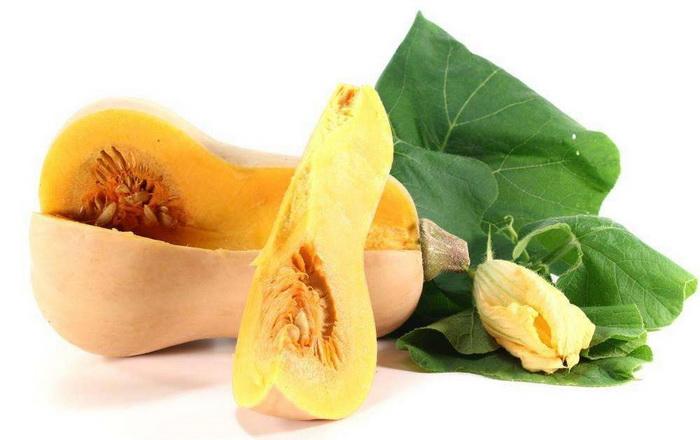
Days From Sowing
Providing severe weather conditions such as drought or prolonged cold temperatures don't occur, butternut squash fruits ripen a predictable number of days after sowing. In regular growing conditions, it takes 80 to 100 days after the seed was sown.
Drought stresses plants, and may speed up ripening. However, cold weather slows down butternut squash growth, and then fruit may ripen later than expected.
Vine Condition
When butternut squash fruits are ready for picking, the vine has done its job. It stops growing and begins to die back. If your butternut squash vine stops producing new shoots and leaves, and the existing leaves begin to yellow and wilt, the fruit is probably nearly ripe.
Skin Appearance
Butternut squash skin is light whitish-green, smooth and shiny while the fruit is growing. As they ripen, the fruits turn deep tan and become dull and dry.
Skin Texture
A change in skin texture is another sign of ripeness in butternut squash. Slightly soft when the fruit is growing, butternut squash skin becomes very tough when the fruit is ripe.
Harvest Time
When butternut squash fruit are ready to harvest, cut the stems with pruning shears or a sharp knife.

Cut the squash stems 1 inch from the fruit, and put them in a cool, dark, dry place. Don't allow the fruit to touch each other. Store the squash at 50 degrees Fahrenheit and 50 to 75 percent humidity and it will keep for two to three months. Check the fruit every one or two weeks, and remove and discard any that look diseased or have begun to decay.

Days From Sowing
Providing severe weather conditions such as drought or prolonged cold temperatures don't occur, butternut squash fruits ripen a predictable number of days after sowing. In regular growing conditions, it takes 80 to 100 days after the seed was sown.
Drought stresses plants, and may speed up ripening. However, cold weather slows down butternut squash growth, and then fruit may ripen later than expected.
Vine Condition
When butternut squash fruits are ready for picking, the vine has done its job. It stops growing and begins to die back. If your butternut squash vine stops producing new shoots and leaves, and the existing leaves begin to yellow and wilt, the fruit is probably nearly ripe.
Skin Appearance
Butternut squash skin is light whitish-green, smooth and shiny while the fruit is growing. As they ripen, the fruits turn deep tan and become dull and dry.
Skin Texture
A change in skin texture is another sign of ripeness in butternut squash. Slightly soft when the fruit is growing, butternut squash skin becomes very tough when the fruit is ripe.
Harvest Time
When butternut squash fruit are ready to harvest, cut the stems with pruning shears or a sharp knife.

Cut the squash stems 1 inch from the fruit, and put them in a cool, dark, dry place. Don't allow the fruit to touch each other. Store the squash at 50 degrees Fahrenheit and 50 to 75 percent humidity and it will keep for two to three months. Check the fruit every one or two weeks, and remove and discard any that look diseased or have begun to decay.
0
0





